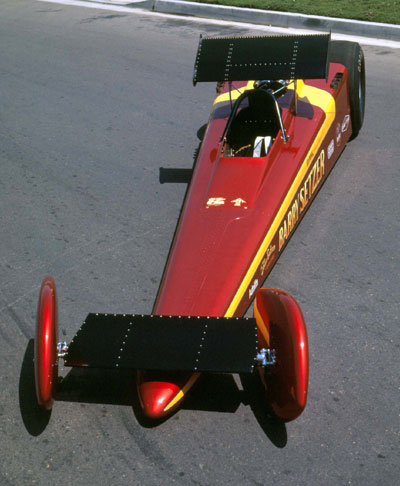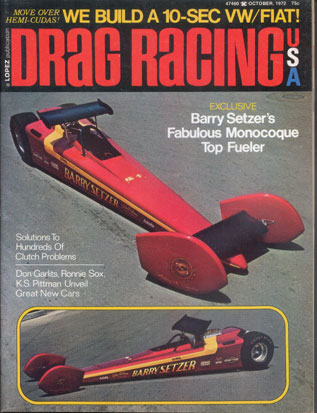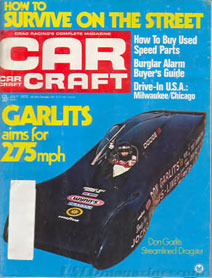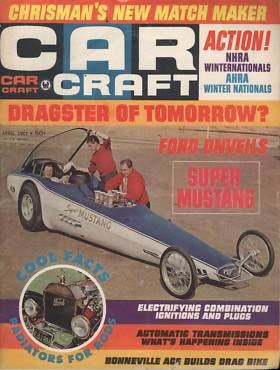

The prettiest car to ever run only once
 |
 |
It was inevitable that our long-running and ongoing discussion of wedge-shaped Top Fuelers would eventually get around to the beautiful but short-lived John Buttera-built monocoque dragster of Barry Setzer. A few of you asked about it, and our old pal Steve Reyes was happy to supply his photos of the car, which graced the cover of the October 1972 issue of the late, great Drag Racing USA magazine.
Buttera built the car in his famous Cerritos, Calif., chassis shop, called Lil' John's Place. He already was a star in the business, having created masterpieces for the likes of Don Schumacher, Don Prudhomme, Mickey Thompson, and plenty of others. He was honored in 1971 as the top Funny Car chassis builder on Car Craft Magazine's All-star Drag Racing Team, and his star clearly was still on the rise.
According to the DRUSA article, the idea for the car began to hatch after Buttera hired aluminum specialist Louie Teckenoff, who had worked for a number of chassis shops as well as on several projects for Thompson, including Thompson's monocoque-chassised Mustang Funny Car. Teckenoff also had a chance to study monocoque construction while a member of A.J. Foyt's Indy car teams in '70 and '71. The two began to discuss the possibilities of a monocoque Top Fueler. Contrary to what most would expect, Setzer, a wealthy textile businessman who already owned the sport's dominant Funny Car, a Pat Foster-shoed Vega built by Buttera, did not commission the car but rather bought it after it was completed.
To backtrack a bit, the term "monocoque" refers to a construction technique that supports structural load by using an object's exterior as opposed to using an internal frame. The word actually comes from the Greek word for single (mono) and the French word for shell (coque), and the technique was already common in the aircraft and aerospace industries as well as a few other forms of motorsports. Drag racers, of course, were using (and still use) a two-part car: a chrome moly tube frame covered by body panels.
The Buttera/Teckenoff car would fuse the body and chassis into a single unit built around a rigid boxlike structure, known as a tub, which becomes the main structural member of the car. Though the design would make for a very strong and rigid car, it was at the complete opposite end of the current design spectrum of the flexible chassis.
The chassis had a wheelbase of 185 inches, and the tub was made of .050-inch-thick magnesium sheet fastened together using both rivets (more than 5,000!) and high-strength adhesives, placing the driver in a virtual cocoon of safety. Three strategically placed bulkheads provided lateral support, and the space between the inner and outer skins of the car was filled with high-density, shock-absorbing foam. Still, despite all of the added gear, Buttera estimated that the completed car was actually lighter than a regular dragster.
 |
The dragster's vaguely wedge-shaped design broadened from its nose to the rear tires to keep the slicks out of the wind, and the front tires were sheathed in that bell-bottom era's drag racing fashion statement of the day, wheel pants. There's a curious passage in the story – "The fairings are also self-centering, meaning that there's more area behind the wheel tub than in front of it, so that any forces on the side of the fairings will tend to straighten the wheels instead of turning them" – that I don’t quite understand but seemed addressed at the issue concerning those front-wheel fairings catching wind and causing the car to veer out of control, which happened to a lot of the cars so equipped and eventually led to NHRA's decision to ban them.
The car had a wing between the front tires and one atop the roll cage – both built by master metalsmith Nye Frank -- and the rear wing was spring-loaded so that the angle of attack would change as the car went down the track to decrease drag. Although the cockpit was open, future plans called for experimentation with a cockpit canopy as well as a dorsal-fin rear wing, a la the Walton-Cerny-Moody dragster.
The car took six months to build and was rolled out of the shop at the end of May, but Buttera realized he could never afford to buy an engine and run the car himself, so he put it up for sale. Apparently, Setzer was looking for new arenas to dominate and had been looking for a Top Fueler. Obviously quite pleased with the performance of his Buttera-built Vega, he bought the car for $15,000.
As far as anyone knows – and Foster and Buttera are no longer with us to confirm – the car made just one pass, during a closed test session at Orange County Int’l Raceway. Reyes said that the car, with Foster at the wheel, "did a huge wheelstand and got bent when returning to Mother Earth. The car was packed up and never saw the quarter-mile again. It was repaired and disappeared. The car now resides in Don Garlits' Museum of Drag Racing in Ocala, Fla."
Reyes (as usual) also had a great story about his photo shoot of the pretty car, one that might not rival the October 1975 week that Time and Newsweek embarrassingly both featured Bruce Springsteen on their covers but that was probably pretty funny in our world.
"It was photographed by Hot Rod and myself a long 37 years ago," said Reyes. "I was allowed to photograph the car after Hot Rod. The gang at Hot Rod thought they had the scoop on this car. It was played up on the cover of Hot Rod magazine and a full spread inside. Alas, then they let me shoot it. So with the late Paul 'Wrong Way' Radici as my helper, the car was photographed in the cul-de-sac adjoining Buttera's shop. My pix and story in Drag Racing USA beat Hot Rod to the newsstand by two weeks."
 |
 |
Collectors will note that the car was on the cover of the September 1972 issue of Hot Rod, but here's why DRUSA actually beat the giant to the public, according to Reyes.
"Mike Doherty, the publisher of Drag Racing USA, hated Petersen and always played with the dates on the issues of DRUSA," said Reyes. "The October issue really hit the newsstand the first week of September, before any of Petersen's magazines September issues hit the newsstands. That drove the Petersen people crazy. They were really pissed, and my name was mud at Petersen for the longest time. I believe he also dated the magazine ahead one month because DRUSA was closed in December; DRUSA was really published 11 times a year, not 12."
So, there you have it. The story to the best of the combined information at hand, though I'm sure (and hopeful) that the Insider Nation will weigh in with additional info.
Of course, cars such as the Setzer dragster make great magazine covers. Witness the same thing below from August 1964, when Tony Nancy's wedge-shaped gas dragster adorned the cover of Hot Rod magazine and the Rossi & Lisa "doorstop" wedge Top Fueler was on the May 1972 cover of Car Craft, followed two months later by Don Garlits' Jocko Johnson-designed Wynn's Liner (whose cover optimistically claims "Garlits aims for 275").
 |
 |
 |
 |
The Car Crafters were apparently very into this type of thing – those covers sold a lot of magazines – as witnessed by this April 1967 shot of yet another Top Fuel albatross, the Super Mustang, which is the subject of my Pure Nostalgia column in this week's National DRAGSTER.
Other than a great photo shoot of the restored car from last year's Meadow Brook Concours d’Elegance in Rochester Hills, Mich., not a lot can be found online about the car, which debuted unspectacularly at the 1967 Winternationals with Tom "the Mongoose" McEwen at the wheel. I didn't have access to that issue of Car Craft – though NHRA's Greg Sharp (naturally) had one he said he could get to – so I dug through old issues of National DRAGSTER and interviewed both McEwen and Dickie Brannan, who was working at Ford's Special Vehicle department at the time with Chuck Foulger. That's Brannan and Foulger on the cover with McEwen.
Between the two of them and other info, I pieced together a better idea about the car, which Brannan said made a few passes in Pomona after its poor Winternationals showing. It had been my understanding that the car was born and died at the Winternationals. Interesting. He couldn’t remember how well it ran, but better than the 8.60 it was credited with during the event.
We had some cool photos that I used to illustrate the article about another great idea that was either before its time or behind in its practicality … you decide.
OK, gang, that's it for today. As always, I look forward to your continued input. I'll see ya later this week.



















































